#post World War II Britain
Text
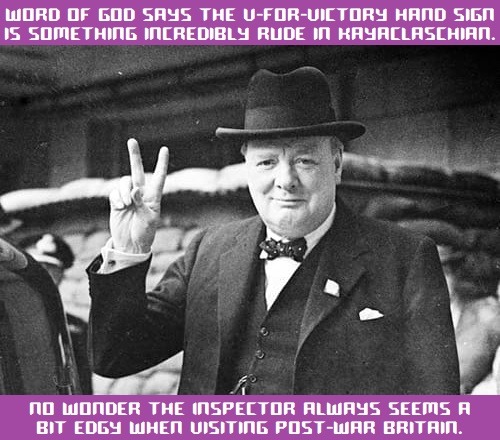
Word of God says the V-for-Victory hand sign is something incredibly rude in Kayaclaschian.
No wonder the Inspector always seems a bit edgy when visiting post-War Britain.
#Inspector Spacetime#Word of God (trope)#Word of God#Pardon My Klingon (trope)#Pardon My Klingon#V for Victory#hand sign#V hand sign#something incredibly rude#in Kayaclaschian#Kayaclaschian#the Inspector (character)#no wonder he/she always seems#a bit edgy#when visiting#post World War II Britain#post war years
0 notes
Photo
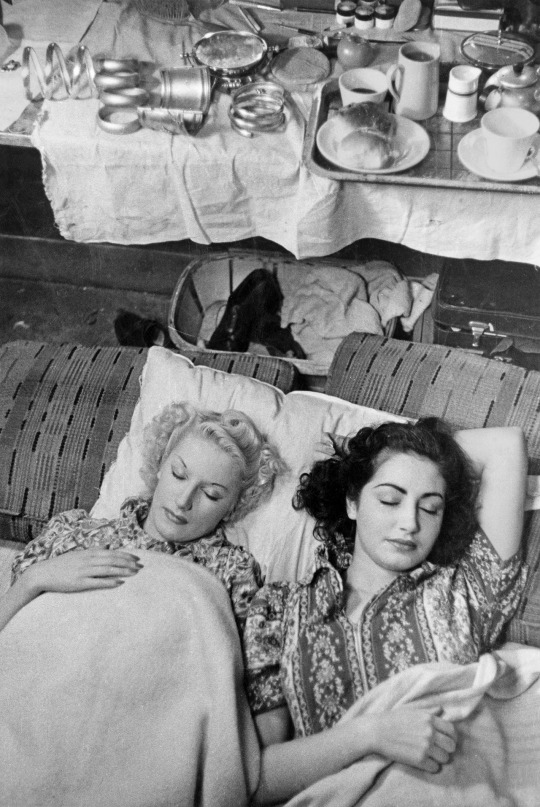
Sonia and Wenda, showgirls at the Windmill Theater, asleep in their dressing room under new rules for the dancers, lights out at 11. The girls dance for six hours then sleep on the floor of their dressing room as they eat, sleep and work at the theater.
"Backstage,” Picture Post, October 19th, 1940
#showgirl#1940s#1940s fashion#vintage fashion#vintage#picture post#windmill theater#backstage#chorus girl#dancer#wwii#world war ii#world war 2#united kingdom#great britain#england#london#home front#black and white#photography#photo edit
229 notes
·
View notes
Text
What Would Have Happened If Britain Lost The Battle Of Britain?
The Battle of Britain was a pivotal moment in World War II, where the British Royal Air Force (RAF) successfully defended the country against the German Luftwaffe. If the outcome had been different and Britain had lost the Battle of Britain, the consequences could have been catastrophic.

Here are some of the potential outcomes if Britain had lost the Battle of Britain:
Invasion of Britain: If the Germans had gained control of the skies over Britain, they would have been able to launch a full-scale invasion. The British Army was not prepared for an invasion at that time, and it is likely that the Germans would have been successful in conquering the country.
German dominance in Europe: With Britain out of the way, Germany would have had a free hand to expand its territory in Europe. It would have been able to conquer more countries and consolidate its power in the continent.
Change in the course of the war: Losing the Battle of Britain would have changed the course of World War II. The war could have dragged on longer, and it is possible that the Allies may not have been successful in defeating Germany.
Impact on the Cold War: The outcome of World War II had a significant impact on the development of the Cold War. If Germany had won the war, it is possible that the Cold War would have played out differently.
#today on tumblr#history#deep thoughts#what if#british imperialism#british empire#great britain#world war 2#black and white#world war ii#world history#late night blogging#blog post#new blog#nazi germany#Adolf hitler#battle of britain#british#winston churchill#peace and love#royal air force#luftwaffe#vietnam war#ww2era
0 notes
Text
[NewYorkTimes is Private US Media]
Over the past month, we’ve watched an astonishing, high-stakes global drama play out in The Hague. A group of countries from the poorer, less powerful bloc some call the global south, led by South Africa, dragged the government of Israel and, by extension, its rich, powerful allies into the top court of the Western rules-based order and accused Israel of prosecuting a brutal war in Gaza that is “genocidal in character.”
The responses to this presentation from the leading nations of that order were quick and blunt.
“Completely unjustified and wrong,” said a statement from Rishi Sunak, Britain’s prime minister.
“Meritless, counterproductive and completely without any basis in fact whatsoever,” said John Kirby, a spokesman for the United States National Security Council.
“The accusation has no basis in fact,” a German government spokesman said, adding that Germany opposed the “political instrumentalization” of the genocide statute.
But on Friday, that court had its say, issuing a sober and careful provisional ruling that doubled as a rebuke to those dismissals. In granting provisional measures, the court affirmed that some of South Africa’s allegations were plausible and called on Israel to take immediate steps to protect civilians, increase the amount of humanitarian aid and punish officials who engaged in violent and incendiary speech. The court stopped short of calling for a cease-fire, but it granted South Africa’s request for provisional measures to prevent further civilian death. For the most part, the court ruled in favor of the global south.[...]
The court was not asked to rule on whether Israel had in fact committed genocide, a matter that is likely to take years to adjudicate. Whatever the eventual outcome of the case, it sets up an epic battle over the meaning and values of the so-called rules-based order. If these rules don’t apply when powerful countries don’t want them to, are they rules at all?
“As long as those who make rules enforce them against others while believing that they and their allies are above those rules, the international governance system is in trouble,” Thuli Madonsela, one of South Africa’s leading legal minds and an architect of its post-apartheid Constitution, told me. “We say these rules are the rules when Russia invades Ukraine or when the Rohingya are being massacred by Myanmar, but if it’s now Israel butchering Palestinians, depriving them of food, displacing them en masse, then the rules don’t apply and whoever tries to apply the rules is antisemitic? It is really putting those rules in jeopardy.”[...]
The military campaign has “wreaked more destruction than the razing of Syria’s Aleppo between 2012 and 2016, Ukraine’s Mariupol or, proportionally, the Allied bombing of Germany in World War II,” the report quoted researchers as saying. The researchers, hardly some raving left-wing activists, are experts cited in one of the most respected news organizations in the world, The Associated Press.[...]
The International Court of Justice issued a nonbinding opinion in 2004 that the security barriers Israel was erecting in the West Bank violated international law, but that ruling has had no effect. The walls still stand.[...]
Indeed, what is a rules-based system if the rules apply only selectively and if seeking to apply them to certain countries is viewed as self-evidently prejudiced? To put it more simply, is there no venue in the international system to which the stateless people of Palestine and their allies and friends can go to seek redress amid the slaughter in Gaza? And if not, what are they to do?
For the cause of Palestinian statehood, every alternative to violence has been virtually snuffed out, in part because Israel’s allies have helped to discredit them. The most recent example is the boycott, divestment and sanctions movement that has, in many places, been successfully tarred as antisemitic or even banned altogether. Efforts to use the United Nations Security Council have drawn U.S. vetoes for decades. Is seeking redress at the appropriate venue for alleged violations of international law also antisemitic, as Israel’s defense minister said on Friday? Does no law apply to Israel? Are there no limits to what it may do to defend itself?[...]
The Biden administration has made the shoring up of the international rules-based order a centerpiece of its foreign policy but, unsurprisingly, has struggled to live up to that aspiration.[...]
Occasionally straying from your principles because circumstances require it is very different from being seen to have no principles at all, and that is precisely how much of the global south has come to regard the United States.
It seems especially shortsighted in these times that the Biden administration elected to wave away the carefully documented case prepared by South Africa. One of the biggest threats to the rules-based international order is the growing consensus in the poor world that the rich world will apply those rules selectively, at its discretion, when it suits the powerful nations that make up the global north, such as when Russia invaded Ukraine.[...]
As far as the rules-based order is concerned, when it comes to crimes like genocide and ethnic cleansing, it simply does not matter who started it. [...] The best way to shore up the rules-based order is to be seen, in word and deed, as committing to the institutions and moral commitments of that order.
28 Jan 24
1K notes
·
View notes
Text
Friends, I have failed you all. I've seen a lot of posts over the last week with a lot of great biographical detail about many of the flyers and aircrew who've been name-dropped so far in Masters of the Air - and I haven't seen a single thing about the one name that is directly in the center of this blog's lane.
In Part 2, returning from their mission to Trondheim, Cleven and Egan walk into the Interrogation hut and Egan accepts a cup of coffee from a woman he thanks as Tatty. Later on, at the dance, James Douglass remarks that he will be 'coming in hot' on one of the American Red Cross women on the other side of the room, and one of his friends asks "General Spaatz's daughter? Or the other one?"
Katherine "Tatty" Spaatz was a member of the American Red Cross Clubmobile service and the daughter of General Carl "Tooey" Spaatz, who commanded the Eighth Air Force on its move to England. (General Spaatz later moved to overall command of the entire Army Air Forces in the Europe Theatre of Operations, or ETO. He is, as the kids say, rather important.)
But we're not talking about him here. We're talking about her.
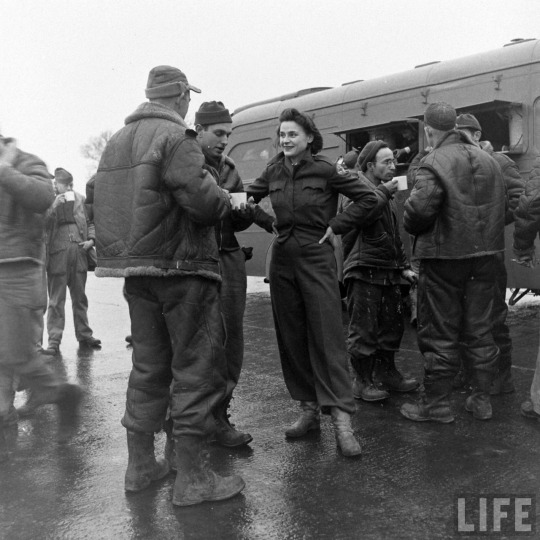
Katherine was 22 years old when she arrived in Europe with the Red Cross. (One of her traveling companions that trip was Kathleen Kennedy, daughter of former U.S. Ambassador Joseph P Kennedy Sr., also coming to serve overseas with the ARC.)
The American Red Cross's mission in Europe had many facets during the Second World War - in addition to activities we might think of today, like collecting blood, providing disaster relief at home and running first aid seminars, they were responsible for collecting and distributing packages for Prisoners of War.
They also operated large canteens like the Rainbow Corner club, a recreational facility in London where soldiers on leave could get a room for the weekend, a bite to eat, and a number of other amenities. Smaller clubs called Donut Dugouts provided a space where a serviceman could always be assured of a cup of hot coffee, a donut, and a pretty girl to talk to, specially recruited for being friendly, fair, approachable, and specially trained to be the girl next door overseas. In addition to these more permanent installations, they also operated the Clubmobile service, a mobile version of their popular Dugouts that moved operations into retooled Green Line Bus Company buses to take donuts and a taste of home to the front line.
Tatty, as she was called, worked on the Clubmobile "North Dakota" along with Julia "Dooley" Townsend, Virginia "Ginny" Sherwood, and Dorothy "Mike" Myrick. Life Magazine did a full article on their clubmobile in February of 1943, which you can read online at the link. There is another lovely blog post with pictures here. She also worked for a time in a more permanent post at the USAAF base at Snetterton Heath, and was later sent to France. You can read a little bit more about her and see more pictures at her bio page at the American Air Museum in Britain website.
If you'd like more information about Tatty, Helen, and women like them, as well as the Clubmobile service, consider reading the following:
Slinging Doughnuts for the Boys by James H. Madison
Battlestars & Doughnuts: World War II Clubmobile Experiences of Mary Metcalfe Rexford
War through the Hole of a Donut, by Angela Petesch
Goodnight, Irene (fiction) - Although this is a novel, it is based on Luis Alberto Urrea's mother's time as a Clubmobile worker and her personal papers.
#women in world war two#women in wartime#original girl gang#american red cross clubmobile service#katherine tatty spaatz#masters of the air#i cannot believe it took me a WHOLE DAMN WEEK
235 notes
·
View notes
Text
The Subtle British Pop Culture/Timeline In CHICKEN RUN
On occasion, I've pointed out when the original CHICKEN RUN is set.

It's often been written that CHICKEN RUN was "set in the '50s", a sort of vague descriptor of its rather dreary post-war England setting. One could assume that from the technology present in the movie, and the homages to 1950s prisoner-of-war films. The obvious ones being STALAG 17 (the number 17 is on the main hut that the chickens all plot in) and THE GREAT ESCAPE. The character Fowler was of the mascot division of the Royal Air Force during World War II. All that talk about his medals. Chocks away!
The easiest way to pinpoint when CHICKEN RUN is set, at the earliest, is knowing what the songs are.
The chickens, in a hut, dance to a cover of Joe Turner's 'Flip, Flop and Fly', Turner's original was released in 1955, an early example of a rock n' roll song. Britain certainly had rock n' roll in a pre-Beatles era, but it doesn't seem as well-known to the average American as American rockers - you know, Elvis, Little Richard, etc. - are to Brits.
Later in the film, Rocky the rooster is jamming out to 'The Wanderer' by Dion.
youtube
The song first appeared in North America in November of 1961 - both as a single and as an album track on RUNAROUND SUE (the title track another big hit for him), and if you look in the opening credits sequence, Mrs. Tweedy works with a calendar that says "November"... However, 'The Wanderer' was first released in the UK in January of 1962. And it doesn't seem like much time has passed since the opening credits and the end of the movie...
'The Wanderer' reached #10 in the UK, which was great for an American rock/pop song over there... If anything, the movie is likely set in November/December 1962, so that was plenty of time for 'The Wanderer' to climb the charts, and then be played on the radio every once in a while. Things took a little while in a pre-streaming age, ya know? *waves cane* *I'm actually not that old, nowhere near lol I just love this kinda pop culture history*

So CHICKEN RUN is still kind of a post-war/pre-Beatles England, and it's set in a secluded location inhabited by a middle-aged couple who likely wouldn't have had any idea what was going in the teen beat scene. The Beatles' 'Love Me Do', the single that really put them on the map in the UK, was released in early October of 1962. Being their first true single (not the 'My Bonnie' recording they did in Germany with Tony Sheridan), it charted at a great #17 in the UK... Which of course was nothing compared to what was to come, the strings of #1s, or at least close to that. 'Please Please Me' was the second single, released in January 1963, it hit #2 in the UK. Beatlemania pretty much becomes a thing in the UK by the middle of 1963... It would take a little while for us yanks to catch the fever...
Anyways, CHICKEN RUN is set in November/December 1962. Or maybe it's 1963, who knows, but I think it's pre-Beatlemania rural England. Yorkshire to be exact.
It's kinda funny how the Disney animated ONE HUNDRED AND ONE DALMATIANS shares some similarities in this regard. That film was released in January 1961, and is set in both London and rural England. Its second half during the late fall/early winter no less. The puppies arrive in October, as stated in the film, and the film ends during Christmastime. Snow everywhere, dreary atmosphere, etc.... And then you have the Tweedys in CHICKEN RUN. Mrs. Tweedy is kind of a combination of Cruella de Vil *and* Jasper. She's got the contempt for animals like Cruella, and is taller and the brains like Jasper. Horace, the shorter, pudgier one in the equation - who is onto what the animals are doing but isn't believed, is totally Mr. Tweedy.
That brings us to the recently-released CHICKEN RUN: DAWN OF THE NUGGET... The sequel swaps prisoner-of-war movies and World War II imagery for James Bond and MISSION: IMPOSSIBLE. Spy movies in general.
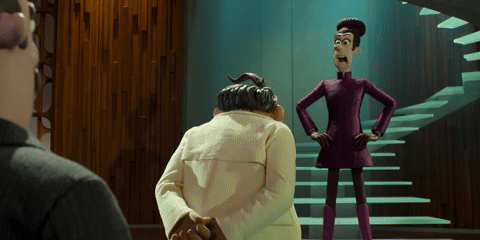
One look at Mrs. Tweedy's high-tech new factory shows that in *spades*. But the folks at Aardman Animations did their homework, a lot of the details and background design and such, it legitimately looks like the lair of a supervillain in a '60s spy movie. Much like how Nomanisan Island does in THE INCREDIBLES, another very midcentury modern-inspired movie and franchise. There's also that charming UPA-esque cartoon on how the chickens are processed into nuggets, great stuff there. I also kind of get a bit of a Gerry Anderson vibe here, too. He was known for marionette shows - done in a process called "Supermarionation" - like THUNDERBIRDS and CAPTAIN SCARLET AND THE MYSTERONS. I assume most of the crew behind these movies grew up watching those shows.
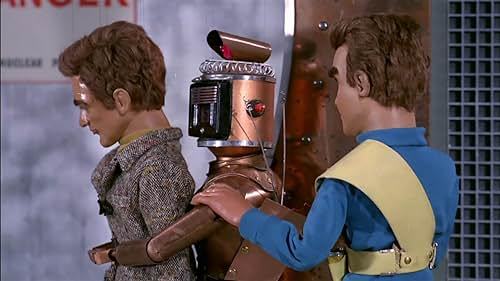

And of course, a big indicator... Towards the end of the film, all the chickens - brainwashed by mind-control collars that make them all happy-go-lucky - are being forced up an escalator to a popcorn chicken death. In this pretty creepy sequence, they're all doing this while Cliff Richard's 'Summer Holiday' plays in the background. The bright, pastel-colored set adorned with simplistic countryside-looking hills that these chickens are brainwashed in before they are to be ground into fast food is reminiscent of vintage British and European children's programs. I was thinking of stuff like THE MAGIC ROUNDABOUT and such, which was also a stop-motion production.

youtube
Oh yeah, 'Summer Holiday'. That song came out in January 1963, it was the title song for a movie that was *huge* in England when it first came out. Cliff Richard is the prime example of a pre-Beatles British pop/rock star, I feel he's almost synonymous with that period of British pop music before John, Paul, George, and Ringo showed up. So, CHICKEN RUN 2 is set *after* January 1963. Plus, Ginger and Rocky's daughter Molly needed some time to grow up a bit.
Either this was intentional or not, but it strangely adds up. It's pretty chronological, either by accident or they made sure they didn't have too many anachronisms... Other than the cartoonishly high tech of Mrs. Tweedy's Fun-Land Farms, but then again, the pie machine in the original CHICKEN RUN was kind of improbable too. But that's the fun of the CHICKEN RUN movies, so it's a staple.
And even in other Aardman works, there are fun nods to British pop culture and media. For example, in WALLACE & GROMIT: THE CURSE OF THE WERE-RABBIT, Art Garfunkel's 'Bright Eyes' can be heard on the car radio in one scene. Garfunkel is American, yes, but 'Bright Eyes' was composed and recorded for the soundtrack of the British animated classic WATERSHIP DOWN. Just in case you've never seen or even heard of that movie. WATERSHIP DOWN is about rabbits, and in the WALLACE & GROMIT movie, they're dealing with rabbits! Quite clever.
Another favorite of mine is in FARMAGEDDON: A SHAUN THE SHEEP MOVIE. Of course, Shaun the Sheep is spun off from WALLACE & GROMIT, he appeared in the short film A CLOSE SHAVE. The second SHAUN THE SHEEP movie brings in science fiction and aliens, a real 180 from the small-scale first film. At the end of the film, the Farmer accidentally gets onto the UFO and is not on Earth anymore! Before they get him back, a song called 'Forever Autumn' can be heard playing on a radio.
'Forever Autumn' is a rewrite of a Lego commercial jingle composed by Jeff Wayne in 1969, with lyrics by Gary Osborne and Paul Vigrass. The two lyricists recorded the first version of that song in 1972 for an album called QUEUES. A couple years later, Jeff Wayne got the idea to do a musical version of H. G. Wells' THE WAR OF THE WORLDS. A musical album, bringing in several mostly British talents to retell - through story and song - the British sci-fi staple. 'Forever Autumn' was covered for the album, with lead vocals sung by Justin Hayward of The Moody Blues. Of course, another British group... all for the section of the album in which the protagonist - a journalist - fears his wife had been killed in the Martian invasion. "'Cause you're not here." Which is the lyric heard in FARMAGEDDON when they realize that the Farmer went to outer space!
(It takes a special kind of skill to take such a depressing song and make it FUNNY in any context.)
Anyways, those are just a couple examples off the top of my head. Aardman's work is distinctly British, to the core. And the CHICKEN RUN movies give me a fascinating idea of when they are set, a very cartoon British '60s.
#chicken run#dawn of the nugget#stop motion#stop motion animation#hyperfixations#timelines#when is this thing set?#aardman#Youtube
85 notes
·
View notes
Photo
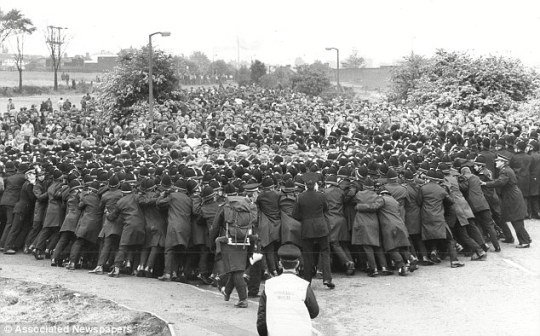
On this day, 18 June 1984, striking workers of the National Union of Mineworkers (NUM) in Britain were assaulted by 6,000 police officers at the Battle of Orgreave. The British government wanted to close 20 coal pits and lay off 20,000 workers. The resulting strike by the NUM was the largest post-World War II strike in Britain with up to 142,000 mineworkers participating. The strike lasted 51 weeks, through 3 March 1985, with no concessions to the workers. Thatcher herself called the workers “the enemy within.” The biggest confrontation of the strike was the Battle of Orgreave. Police armed with round shields and batons, and horse-mounted police, charged the miners. This was the first use of such aggressive tactics in Britain, which were imported from British colonial police forces’ experience suppressing riots of colonised peoples around the world. One officer has said they were instructed to “use as much force as possible,” and the miners were “actually doing nothing” when the charge occurred. 95 miners were arrested and charged with rioting. Many remained in prison while waiting a year for the cases to be brought before a judge. Within 10 days in court, the prosecutors withdrew the charges due to obvious signs of fabricated evidence and lies on the part of the police officers. Many of the miners sued for assault, wrongful arrest, and malicious prosecution, and the South Yorkshire Police paid out £425,000 in damages without admitting fault. In 2012, a BBC investigation revealed that many of the police statements may have been “coached” or fabricated, leading the modern South Yorkshire Police to submit itself to the review of the Independent Police Complaints Commission. The IPCC declined to investigate, and the victims of the Battle of Orgreave are still waiting for full justice. Learn more about the dispute in our podcast series: https://workingclasshistory.com/tag/1984-5-miners-strike/ https://www.facebook.com/photo.php?fbid=646551040851448&set=a.602588028581083&type=3
187 notes
·
View notes
Photo


Apparently, Molly is low-key a major gay icon, and honestly, I get it. After all, Molly did *really* like her pretty teacher, Miss Campbell. If you think about it, it makes sense that lot of future lesbians would absolutely love Molly. Most dolls in the 90s were hyper-feminine princess dolls, and Molly was... not. I’d imagine the market for girls who want to play with dolls that aren’t pretty pink princesses is pretty large and the supply is pretty small. Just like there’s plenty of boys out there who want to play with something other than GI Joes. Molly (and AG in general) fits neatly into that market, which I’m sure is why she was so successful.
Last year, with its re-launch of the classic dolls, AG put a post on it’s instagram, “To all the Molly girls in the world, we see you and celebrate you,” which a lot of folks on Twitter took to see as confirmation that Molly was gay. When asked if they just outed Molly, AG gave a very non-committal reply. AG has always had a distinctly feminist slant, but it’s only ever toed the line of actually being LGBT inclusive. So far the only actual inclusion we’ve seen from them is a Girl of the Year with a pair of gay aunts. Even that tiny whiff of queerness was enough to set off a frothing horde of angry conservative moms screaming for a boycott. Since Mattell is only motivated by profit, I doubt we’ll get more representation any time soon, but we can dream.
Anyway, World War II was pretty gay to begin with.


A lot of historians point to WW2 as the starting point of the modern gay rights movement because before it, you had very many people living on isolated farms and never going very far from home in their lifetimes. With mass recruitment of men into the military, gay servicemen were able to find other men like themselves and build a community. It was much the same way for women who went to work in factories, joined the WAC or WAVES, and joined women’s baseball leagues. That’s right, the league of their own was gay as FUCK.
As far as Molly’s fashion goes, I love her lack of pink. I’m glad there’s a doll out there that isn’t hyper-gendered, and I wish there were more dolls like her out there.
With sweaters coming into fashion in the 1920s and 30s, the sweaters of the 40s started to see more complex and colorful knits coming into style.

Much of the fashion of this era was dominated by frugality. Europe’s couture houses were shut down, and fabric was rationed. Hems were shortened and baggy cuts and useless frills were done away with. Britain introduced the “Utility Scheme” which hired designers to make chic ensembles using as few resources as possible. Because of this, separates and outfits that could be made with scraps of fabric were very popular, and at-home knitting and sewing continued to be highly popular.
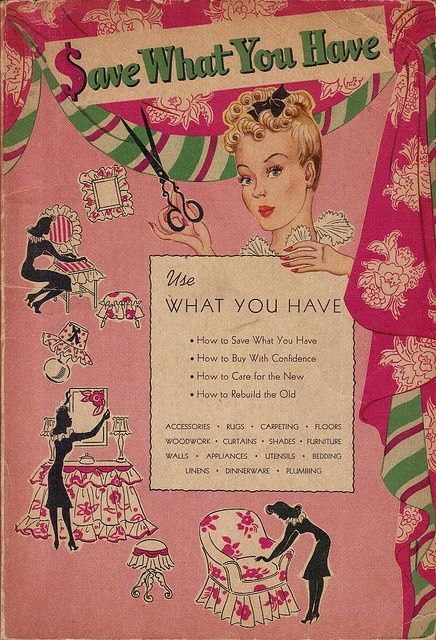

“After the United States entered World War II in 1941, companies began to experiment with various materials in anticipation of rationing and shortages. This example is a prototype from Nina-Fay Foundations, which uses plastic for closures and stays instead of the usual metal. Although metal was not ultimately rationed, the company was experimenting with alternatives to metal zippers and hooks in the event that it was needed for the war effort.”
(The Met Museum)
Women were taking men’s jobs and taking on masculine roles
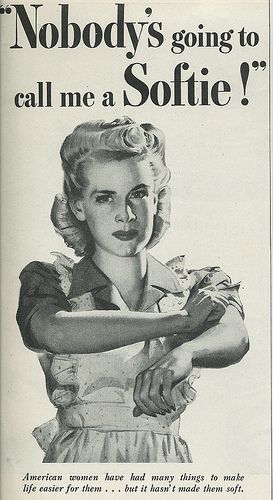
But they were still expected to maintain a certain level of femininity, “To give our boys something to fight for.”

Because of all of this, the gender politics of the 1940s are really complicated and interesting.
298 notes
·
View notes
Text
The link between warfare and technological innovation has been well documented [...]. World War II was a particularly intense crucible of technological change, and the repurposing of military technologies and industries in the forging of a new post-war consumer [economy] is crucial [...]. Processes of technological bricolage turned the machines of war onto the natural world as global powers competed to cement their economic and imperial hegemony. In Great Britain’s post-war “groundnut scheme” in its East African territories (1946–51), this collision of nature, military hardware, and technical expertise was part of efforts to both produce more fats for the British diet and to demonstrate to the world (most importantly the United States) that, through a newly energized science-led developmentalism, British colonialism still had a “progressive” role to play in the postwar world.

The aim was to produce millions of tons of peanuts across Tanganyika using the latest methods of advanced scientific agriculture. The environmental conditions in the north, where the scheme was to begin, were known to be especially trying, not least the dry climate [...]. But faith in the power of mechanized agriculture was such that any natural limits were thought to be readily surmountable.
The groundnut scheme was to be, as its Director put it in an interview with the Tanganyika Standard, a “war” with nature, and an “economic Battle of Alamein” waged over some three million acres by an army of colonial technicians -- many recruited from military ranks -- and local laborers, for many of whom the scheme represented their first entry into the wage labor market.
---
But it wasn’t just the rhetoric of war that was repurposed.
Lancaster bombers were kitted out to survey and discover “new country” in East Africa for agricultural development. [...] [T]ractors and bulldozers from military surplus stores in Egypt proved unable to tackle the hard ground and tough vegetation, so the planners turned to a novel solution: repurposing surplus Sherman M4A2 tanks. The Vickers-Armstrong factory in Newcastle-Upon-Tyne set about rearranging key elements of the tanks’ construction [...]. The tractors, christened “Shervicks” for their hybrid origins, were [...] thought to be particularly suited to large-scale earth-moving and to the kind of heavy duty “bush clearing” that was required in Tanganyika.
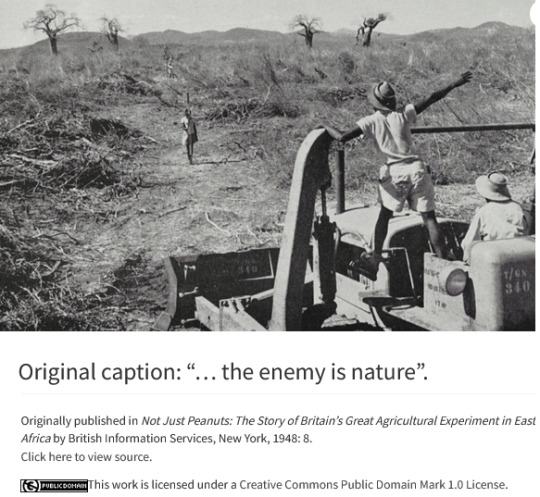
Officials sought to dismiss concerns that large-scale bush clearing would have wider environmental consequences, using the well-worn colonial trope that any observed changes in local climate or erosion patterns were due to the “primitive” agricultural practices of the locals, not to the earth-moving practices of the colonists.
Albert Walter, who had directed meteorology in East Africa since the 1920s, had been appointed as an advisor to the scheme and warned the other technical advisers of the low rainfall levels. [...] As the plants continued to wilt in the sun, Walter’s dense network of rain gauges made for an ideal field laboratory [...].

The stakes were high. As John Rosa of the Colonial Development Corporation put it in a letter: “Our standing as an Imperial power in Africa is to a substantial extent bound up with the future of this scheme. To abandon it would be a humiliating blow to our prestige everywhere.”
The only option left was to try and bend the weather itself to the scheme’s will, by seeding the clouds for rain. The scheme was nonetheless abandoned by the British government before charcoal burners could be lined up to seed clouds upwind of the growing area. But the experiments carried on under the aegis of the local colonial government and its meteorologists.
“Balloon bombs” (photographic film canisters tethered to weather balloons) and a repurposed Royal Navy flare gun were used to target individual clouds when the burners proved imprecise. [...] The rainmaking experiments lived on too, as a reference point for those who, to this day, seek to engineer the skies.
The scheme itself has survived as a cautionary tale of governmental hubris, but it is instructive too as a case study of how technologies of war have been turned against other foes.
---
All images, captions, and text by: Martin Mahony. “The Enemy is Nature: Military Machines and Technological Bricolage in Britain’s ‘Great Agricultural Experiment.’“ Environment and Society Portal, Arcadia no. 11. Rachel Carson Center for Environment and Society. Spring 2021. [Bold emphasis and some paragraph breaks/contractions added by me.]
91 notes
·
View notes
Text
In a world where discussions of immigration and national identity often spark controversy, Britain's history offers a complicated story that challenges certain nationalist and anti-immigration policies. From the ancient Romans to the post-World War II Windrush Generation, waves of immigrants have left an indelible mark on British culture.
Robert Winder's seminal work, “Bloody Foreigners,” sheds light on this rich tapestry of diversity, revealing how seemingly quintessential aspects of Britishness are, in fact, imports from other cultures.
Delving into Britain's multicultural past uncovers a story of resilience, adaptation and integration, where cultural exchanges have contributed to Britain's national identity. In fact, many aspects held dear as quintessentially "British" are actually cultural imports integrated into everyday life.
20 notes
·
View notes
Text
Gerhard Barkhorn timeline

This is Gerhard Barkhorn, the second greatest flying ace in history, timeline:
1919: He was born in Königsberg
1937: He joined the Luftwaffe.
1938: He started his pilot training.
1939: The Second World War began.
1940: He was moved to the 6th squadron of the 2nd group of the 52nd fighter wing (6./II.JG 52) to participate in the Battle of Britain, without achieving any victory and instead being shot down twice.
1941: JG 52 was transferred to the east and participated in Operation Barbarossa.
1941: He scored his first victory
1941: He was promoted to Oberleutnant.
1942: He was appointed Staffelkapitän (squadron leader) of 4./JG 52.
1942: He received the Ritterkreuz for having shot down a total of 59 aircraft.
1942: He received the Luftwaffe honor cup.
1943: He was awarded Oak Leaves to his Knight's Cross.
1943: He was appointed Gruppenkommandeur of II./JG 52.
1943: He reached the 200 mark on 30 November.
1944: He was awarded the Swords to his Knight's Cross.
1944: He attended the wedding of fellow ace Erich Hartmann as best man
1944: He was promoted to major.
1945: He scored his 301st (and final) victory.
1945: He was assigned as Geschwaderkommodore to Jagdgeschwader 6 (JG 6), a unit assigned to defend the Reich.
1945: The Second World War ended.
1956: He joined the Bundesluftwaffe, rose to command JaboG 31 Boelcke.
1983: On 6 January , during a winter storm on an autobahn near Cologne, he and his wife Christl were involved in a car accident; his wife died instantly and Barkhorn died in hospital on 8 January . They were buried in Tegernsee, Bavaria.
Sources:
Wikipedia: Gerhard Barkhorn
Military Wiki: Gerhard Barkhorn
❗❗I DON'T SUPPORT NAZISM,FASCISM OR ZIONISM IN ANY WAY, THIS IS AN EDUCATIONAL POST❗❗
33 notes
·
View notes
Text
The Statute of Secrecy 📜

Disclaimer: This is just my personal opinion. I'm sorry if this was answered late but... I just wanted to answer this properly. And perhaps a late birthday post! 🎉 I'd love to hear more thoughts in the comments section or give me more asks!
The anon was pertaining to a previous post of mine, which you can find here.
Once again, this is a very, very long post. ✨ Please take your time!

Thank you so much for sending me this ask. This is my first one ever, and I couldn't be happier! You have no idea how long I've been stewing on this topic but didn't know where to start.
Let's talk about it! I originally just wanted to post my vague take about this topic but I got to thinking 🤔 If we're really going to talk about this, let's delve deep into it, and get all the proper information out. Lots of people are divided about this statute; some in agreeance, some in complete opposition.
Also, I know that I'm no expert in the areas of government that I'm going to mention here. But I think I have a decent handle on the topic at hand, and for once, I'd like to put my degree on International Relations and Politics to good use!

What is the Statute of Secrecy?
According to the wiki, the International Statute of Wizarding Secrecy (commonly shortened to Statute of Secrecy) was a law in the Wizarding World that was first signed in 1689, then established officially in 1692. The purpose of this law was to safeguard the wizarding community from Muggles, and hide its presence from the world at large. This statute was inveterated by the International Confederation of Wizards — which is the equivalent of the United Nations in the muggle world.
The ultimate reason as to why this law had to be made and laid down in the 17th century was due to the severe Wizard-Muggle relations at that time. Witch trials were at an all-time-high across European nations. It was said that, "...[witches and wizards] that offer to aid their muggle neighbors with the use of magic was tantamount to volunteering to fetch the firewood for one's own funeral pure." This was evident in the many witches and wizards that were imprisoned and sentenced to death on the charge of practicing witchcraft.
On top of that, there had also been a time of widespread persecution of wizarding children by muggles, and both witches and wizards being forced by muggles to perform and teach magic for the latter's benefit; thus, increasing the numbers of persecution that inevitably included those of muggles mistakenly tried and burned as witches. At this point in time, the Wizarding World had to establish interventional measures.
During that period, Great Britain was ruled by King William III alongside his wife, Queen Mary II. There was a time during their reign when the newly-created Ministry of Magic attempted to convene with the muggle British Monarchy via a special Ministry Delegation. The British Wizarding World went as far as begging the muggle monarchy for the protection of wizards under muggle law. Of course, this attempt had failed, which promptly resulted in the collective decision of Wizardkind to voluntarily remove themselves from muggle societies, and went towards the direction of hiding and secrecy.
Now that the historical background of this law has been covered, let's now talk about what would happen if the Statute of Secrecy were to be abolished; which will make the Wizarding World known to all muggles. (Again, these are my personal views and hypotheses, backed by ample amount of research from both sides of the debate).
Of course, in an ideal world, we would all be accepting of each other, holding hands and singing Kumbaya. 😀🤝😀
But given the current status of wars we're facing today, we have to be honest with each other here. The power of love and acceptance is not going to be enough if the muggles themselves cannot even reach an amicable understanding between themselves. And this is without magic to begin with!
So, what will happen if the Wizarding World were to reveal themselves to the muggles?

I. Economic Repercussions
There are so many bases to cover when it comes to the economic impact of what the abolishment of the Statute would entail. If the Wizarding World were to reveal their truth during this time, I can only imagine the economic upheaval both the muggle and wizards will face. Assuming that the Wizarding World would unveil themselves today, year 2023, these are the highly anticipated events that may occur:
1. At least half of the Muggle jobs will be obsolete
The first that comes to mind are people who work blue-collar jobs. I believe they will be hit the hardest in the event that magic will be known.
Why would you need a couple of dozen of construction workers (who work at a slower pace, and costs more) if you have magic to do if for you; which is considerably cheaper, faster, more efficient, and safer for all who are involved? Sure, wizarding engineers do exist as Hogwarts was built both by hand and magic. But for the most part? Utilizing magic to build and construct infrastructure will be far easier and faster than its muggle counterparts. This alone would affect the economy of manual labor of the muggle workforce.
How about housekeepers? Servers? Customer service? Handymans? They are surely the backbone of our society. But with the integration of magic, again, it would be cheaper to hire one witch or wizard to do the job, and it would be faster if magic was involved with stacking grocery goods into shelves, enchanted clothing stores that automatically alter your clothes to your size and shape, and a swish of the Scouring Charm (a charm used for cleaning and washing things) will inevitably cut the muggle labor-force into considerable numbers.
Didn't we see the Leaky Cauldron's tables being cleaned and chairs being put up by one wizard? A restaurant wouldn't need lots of servers if this would be the case. That alone would wreak havoc on muggle economy. (Less workers = less income tax revenue for the muggle government).
We've seen in real life how the recent pandemic messed with our economic recovery simply because the service industry was not wholly available as it used to be during pre-pandemic times. Everything else became impossibly expensive and difficult to obtain.
2. Pharmaceutical Corporations and Insurance Companies
Come on, now. We all know this is a gargantuan beast to tackle.
The first thing that came to mind are the magical creatures and plants that will be harvested to extinction if the muggles knew of their medicinal properties. Poaching will be at an its height (poor Poppy) with both muggles and crooked wizards selling and auctioning these creatures for mass breeding programs. There will be a race to find and get ahold of the rarest magical creatures, such as the Phoenix, Unicorn, and some species of Dragons and Winged Horses.
Wizarding potioneers and apothecaries will be reaping the benefits of this, of course, but they will be swamped with millions (if not, billions) of desperate muggles who are in search of cures for their ailments. Skele-Gro for immediate regrowth of bone-related accidents, Wiggenweld for the immediate treatment of open wounds and post-operative incisions, and the Forgetfulness Potion and Draught of Peace for patients who are suffering PTSD or any other trauma-related symptoms; just to name a few.
But the most dangerous part is that there will be a race for the recreation of the Philosopher's Stone. This is the key to create the Elixir of Life. And this is something both the wizarding world and the muggle world will fight to the death over.
Muggle pharmaceutical corporations will be affected considerably due to the magical competition of potions and healing spells that are far better than some of the muggle medications. However, there are still medicines that are needed and irreplaceable at this time; such as post-operative maintenance medicine, emergency care, anti-psychotic drugs, chemotherapy, anti-seizure aid, and the like.
And as much as we all loathe our respective countries' insurance companies and policies, they are still an important factor in our economic system. These companies will also be affected by the decline of both muggle medicinal and medical procedures.
3. Doctors, Nurses, and Healthcare Professionals
In that same vein, all healthcare professionals and providers will be affected. There will be a demand for more wizarding healers than doctors, and there will be an influx of muggle patients seeking treatment from the Wizarding World. Yes, there will be muggles who will still be wary and untrusting of wizarding procedures. This will be the saving grace of the muggle doctors and nurses — but only for a little while. Once the legitimacy and credibility of wizarding medicine becomes apparent (which it will over time), lots of muggle physicians will be at a loss of employment as more and more wizarding healers will be on demand worldwide.
The bright side to this dilemma is if both wizard and muggle medical professionals learn to cooperate with one another and have an exchange of training information with each other. Wizarding healers can learn how to do first aid; such as CPR, resuscitation, defibrillation, Heimlich maneuver, etc. We also have to give lots and lots of credit to the muggles. We have survived thus far with our own studies and the sheer will to live.
And so, we also have a lot of knowledge to impart to the wizard healers. Surgery would be even more revolutionary with the brainpower of muggle surgeons and wizard healer's magic and potions; perhaps to the point where mortality rates would go even lower than what we currently have. Maybe the muggles would give the wizards an idea of replicating organs instead of relying on donors! These are some of the positives that can happen for sure.
The Wizarding World will finally get to know dentistry! 😂 I honestly can't believe they don't know the existence of dentists all the way to as late as the 1990's.
4. Transportation
Commercial air and sea travel will most definitely be hit by the presence of wizarding means of transport. Imagine: Floo Stations can be built almost entirely anywhere (from major cities to remote islands), Witches and Wizards can be hired to apparate and disapparate (making traveling much faster, given the Wizarding World could figure out a way to bypass splinching), and Portkeys can be made and sold for a price! (There had been an incident where a muggle accidentally touched a Portkey, and was transported in the middle of a Celestina Warbeck concert!)
Surely, the muggle way of transporting goods will still be there simply because there is just too many parcels and packages to deliver. But human transportation will be affected, putting a dent the industry of airlines and seafaring companies. Plus, wizarding travel methods are easier on the planet! They don't use fuel and gas to begin with.
Another thing is broom flight! Yes, it's fun for the most part. But there will need to be an entirely new set of transportation systems and rules to be implemented before it can even be introduced for public consumption. I assume it's cheaper to buy than a car, and so a lot of muggles will be enticed to opt for brooms instead of cars — and they can just hire the aid of wizards to enchant their bags with Extension Charms for their personal belongings.
But ultimately, automobile manufacturers and corporations will, once again, become obsolete. It would push for smaller car companies into bankruptcy, and the larger ones would probably have to sell their now-surplus stock of cars for a drastically cheaper price just to be sold. Can you imagine what this would do to the economy?
5. Muggle-Made Products vs. Magically Modified Products
Funny enough, I added this part last-minute. But I immediately thought about this from seeing a review of Lady Gaga's beauty brand, Haus Labs, and their "Atomic Lip Lacquer." A product review said:
I'm 100% convinced Lady Gaga found some glamour witches and hired them! This product is impossibly good and effective!
This set my idea lightbulbs off because true enough, I had sampled this product before — and it works! It's smudge-proof, transfer-proof, and the color is quite universal on a lot of skin tones. (This is not an advertisement, nor is this post sponsored by Lady Gaga). 😂
But of course, the caveat is that if this truly was enhanced by glamour witches, then there will be a problem. Right now, we know that Haus Labs probably just have really good cosmetic chemists in their lab. But if the world was to know that glamour witches can be hired to amp up certain products, there will be a power and economic impact in the market competition.
Sure, all major companies can hire their own witches and wizards to magically enhance their products. But what about small, family-owned businesses? What about those actually honest companies that pay their workers fair wages? What about small companies who rely on ethically-sourced products from indigenous communities; like woven garments and furniture? What happens to them, then? They will be obliterated by these major corporations who have the money to hire people of magic to modify their products that will ultimately (and unfortunately) overpower smaller businesses.
Even if we are to ethically buy muggle-made products in support of their honest work, it will become much more expensive to procure over time. Much like cultural products made by locals are more expensive than your factory-produced goods, even the masses will have no choice but to buy products that are magically enhanced because they're cheaper and they take less time to manufacture. And most importantly, the magical products are going to be much more effective.
Just like that Atomic Lip Lacquer.
6. Currency, Trade, and Stock Markets
This one's pretty straightforward. With the use of divination, legilimency, seers, and all sorts of other methods of prediction, the odds are in the wizards' favor. Even with muggle technology that aids them in stock market predictions, it wouldn't stand a chance against magical seers and divination. Not only that but it would wreak havoc upon the value of both muggle and Wizarding currency exchange.
Since their community is considerably smaller than the rest of the world's, their economy is pretty stable. The system of currency isn't really expounded in great detail in the books, aside from what we know that there are 29 Knuts for 1 Sickle, and there are 17 Sickles for 1 Galleon.

Interestingly, there have been systems from forums and websites that have shown the actual money exchange rates between the Wizarding and the muggle currency:

(This one, however, is no longer the actual rates because we all know that rates change daily. There used to be a website for daily conversion rates but it's currently inaccessible or have been taken down. Do try to see if this website's working by the time I published this post).
I am not an economist, and I suck at economics, but judging from how a Galleon is worth more than the Euro, the US dollar, and British pound, Wizarding currency is more powerful than muggle currencies. If the Statute would be taken down, the Galleon would now have to enter the International Stock Exchange! But the worst part is that the British Galleon is not the only Wizarding currency there is. In France, they operate with the Bezant (which was established around 1927), and in the US, they have the Dragot and the Sprink (from at least the 18th century).
Yes, Gringotts Bank do accept muggle currency for Galleons in the case that muggleborns needed to have them exchanged. But the goblins do find the way to put muggle money back into circulation. So, in reality, muggle money is worthless in the Wizarding World. Not only that, but assuming that Galleons are made from gold, that in itself will cause a lot of confusion as to how it would be converted, and which method of conversion would yield higher returns. The bottom line is that the Wizarding currency would suffer from the process of joining the muggle market.
—
🔹 Now these are the things that I can think of at the moment, but I'm sure there are tons of other things to consider. We're barely scratching the surface of the economic repercussions. Sure, there are advantages in the long run. But will the muggles and wizards even get to the long run with other factors to consider?

II. Religious Opposition
(Note: I am NOT pertaining to the derogation of any specific religion on this section of the post. Anything mentioned here is alluded to in a generic way or historical context. I am not siding nor criticizing any particular group or religious organization by refering to "real life" events; I am merely making historical references that align with the canonical events in the Harry Potter universe).
—
One of the other factors that I just mentioned is the religious opposition the Wizarding World will inevitably face. The contrasting beliefs and practices of the Wizarding World against the muggle religious organizations is the prime reason why the International Statute of Secrecy had to be made to begin with.
There are extensive historical references, records, and studies about the subject of the European Witch Hunts and Trials that go way back to the 1400's. There was a book — which is famous, even today — that is considered as the "handbook" of identifying, capturing, torturing, and executing a witch in captivity. This is called the Malleus Maleficarum, also known as the 'Hammer of Witches.'
It is because of this book that tens of thousands of people, 80% of them were women, have been put to death. Inevitably, this became the ultimate cause why the Wizarding World have decided to completely go into hiding. The differences in the acceptance of religious beliefs and practices were the driving force why the Statute of Secrecy had been passed and enforced.
Given that today's religious climate is arguably better than how it used to be during those days, there is a bigger and better chance that the youth will have a far greater sense of open-mindedness about the existence of witches and wizards. A lot of Millennials, Generation Z, and the oldest of Generation Alpha are scientifically considered smarter and the most educated generations in all of modern history. We are, as a collective whole, the most progressive and accepting when it comes to considering things that are unknown or are yet to be discovered. Most of us won't react with violence or have the need to gather our pitchforks against the Wizarding World.
However, the same couldn't be said for religious orders. Witchcraft and wizardry are real punishable violations under scriptures, and the history of this practice is one of dark times. If the Wizarding World is to be revealed to the masses, alongside the demonstrations of magic for everyone to witness, religious organizations will most likely take action against the Wizarding population. It would not be a surprise if religious extremists host groups of people willing to revive witch hunts and take matters into their own hands, citing holy scriptures and rights against the perceived enemy. (Keyword: Extremists; not the religious organizations as a whole).
Taking note of the political upheaval in today's warring nations (and to completely acknowledge the severity of what's going on these days without disrespecting real-life situations), muggles alone have taken part in religious crusades after another. Dominant empires of the past have conquered and colonized solitary societies who are living in peace solely in the name of their respective religions. We see this even today. It is not far-fetched to think that some (not all) factions within religious organizations will take up arms against the Wizarding World. It is easier to find a common enemy to attack and fight against. It is easier to wave white flags toward your usual enemy, and join forces to defeat the new threat.
On the other hand, we see a new wave of several revivals of pagan faiths by today's youth. More and more people participate in different forms of divination (such as tarot and astrology; here's my shameless plug: @tarotwitchy), some practice the Goetic rituals and methods of communicating with deities and spirits, others prefer to continue with their ancestors' lost pagan traditions according to their ethnic roots.
So, that is a good thing... right? Unfortunately for the youth, majority of world religious leaders are the elderly; who have grown accustomed to conservative and very traditional practices and systems. And while there's technically nothing wrong with that, I personally do not see them willing to put aside their beliefs in order to allow the Wizarding World to be acquainted and assimilated in the muggle world. Pagan and indigenous spiritual people (and those who have folk religions in their cultural heritage) have a higher chance of tolerance towards the new comers. Again, I could be wrong, and I'm very open for discussion. But the judging from the current situation of the world, muggles cannot even set aside their differences to realize that we're all human with the right to live. What more when it comes to a completely new "species" of humans that will most definitely be perceived as a threat?

III. Cultural Nuances
There are obvious cultural nuances when it comes to the acceptance of the practice of witchcraft around the world; as a matter of fact, it wouldn't be so popular in today's new age of spiritual resurgence if these nuances haven't been a part of ethnic cultures in the first place. Some countries in Asia, Africa, Eastern and Southeastern Europe, the Carribean, and in Central and South America, witchcraft is basically a part of "folk culture," wherein the practice is deeply embedded into the traditional heritage of the people. Some cultures do not necessarily look upon witchcraft and wizardry as evil practices but something to respect (or at the very least, steer clear from out of ambivalence).
I can only speak for my own culture, but here in my country, located in Southeast Asia, we are part of a handful of countries that practice "folk Catholicism." This is when the influence of colonial religions have meshed alongside the natives' pagan traditions and practices. The assimilation of the two groups make for quite an interesting culture! Here, as much as 86% of the population are Catholic. But in spite of the clear-cut religious law that witchcraft and wizardry are not to be tolerated, the indigenous roots of folk practices can never be forgotten nor erased. For example, whenever the Church has done all they could do to help someone under spiritual attack, most people would turn to the ancient pagan practices for cures and solutions.
And I know we aren't the only country that does this. The Haitians and Romanians also have these practices deeply embedded in their culture. (I don't claim to expertly know about these countries, and I understand that not all citizens of those two nations practice witchcraft and wizardry). Mesoamerican culture entails the assimilation of the Catholic faith and its indigenous beliefs as well! (This was a really interesting and enlightening read for me to have researched, and people should read about it, too).
Therefore, I think majority of the muggle population around the world would have a lukewarm reception of the revelation of magic, in general. Of course, there will be fear. There will be wary people who might even spurn the existence entirely. But with how the younger generations have been extremely curious and eager to participate in these practices with an open mind, I wouldn't be surprised if the culture of the Wizarding World will be assimilated into the mainstream in just under a decade. That is, idealistically speaking, if the younger generation would really push for the human rights of the wizards as well. None of this would matter if wizards won't be given the same human rights and freedom as the next muggle. Only then would the wizards be granted the lawful freedom of practicing their own culture (besides other lawful implications and regulations).
Nevertheless, as good as that sounded on paper, greediness and envy does not have an age bracket. Both young and old will be tempted to take advantage of magic simply because it is power, in its natural form. You can see this phenomenon happening in high school students' social experiments; wherein one group of students are being given good school materials, better grades, more attention from teachers than the other group. The less "privileged" group of students began to complain and raise their concerns, and some even gave up entirely. But at the end, since their concerns were left unheard, they plotted against the other group to covet what those students have for themselves.
Of course, these feelings can somehow be justified on the perspective of the muggles. Why should the wizards have all the power? Now that they revealed themselves, they should also share their magic! These muggle concerns, in turn, will alarm and scare the Wizarding World even more. Given their respective histories, they didn't have a good parting to begin with. And this is why, on the grounds of Cultural Nuances, it would really depend on the heritage of the country or region; and how they received and perceived witchcraft and wizardry throughout their histories.

IV. Sociopolitical Upheaval and Power Vacuums
[Note: I have seen and read different takes on this issue, and I must say, there are some who see this issue in an entirely new light that I haven't considered before. Alongside my own personal research and beliefs, I will try to put all of the information together in a cohesive way. Again, all of these are the amalgamation of my own opinions and of others'. This post is for entertainment purposes only, and I am in no way pertaining or pointing fingers to a specific governmental body of any nation in real life. If there are countries mentioned in this segment, it's only because of comparison, and I'm correlating the given information that coincides with the Harry Potter universe]. 🙂
—
A little interesting fact: It was common knowledge that the Malfoys used to be staunch and vocal protesters against the Statute. Why? Well, during the time before the Statute, they enjoyed being part of high-society muggle circles that ensured the steady rise of their wealth from collecting muggle artifacts, currency, and assets. They also used to align themselves with the muggle monarchy, providing discreet (and shady) services to King William the First. The Crown rewarded these services by giving them annexed land from local landowners in Wiltshire — that's why they have a huge manor! But when the new law was passed, the Malfoys became adamant in their denials of interactions with upperclass and royalty muggles.
Now, the discovery of the existence of the Wizarding World can most certainly go in so many different directions. I'm about 99.99% sure that at least half of the world's governments would not take kindly to this shocking revelation. Personally, these are the things I think would happen from the moment witches and wizards made themselves known to the masses, to name a few:
1. Governments would be on high alert
The first thing that I can imagine happening is that the muggle world will be in a state of frenzy. The simple fact that the Wizarding World has managed to hide under the muggles' noses this entire time could make the majority believe that they are not safe at all. If the wizards have lasted this long without the muggles knowing their existence, what else could they be hiding, right? Not only would the public masses become paranoid and fearful of their surroundings, their respective governments will issue a high-alert status all over their nations.
Remember, the wizards are considered the aliens and new outsiders in this scenario. We've seen time and time again in different movies (Transformers, The Fourth Kind, Signs, 10 Cloverfield Lane, Arrival, Edge of Tomorrow, and The 5th Wave) that humans in general will employ all strategies to contain and annihilate the foreign species. And so, this is most likely the first thing muggle governments would do. It wouldn't be far-fetched if these world leaders might also go as far as to call for martial laws to their countries for total control over all citizens. But of course, this would just be a façade for what would actually happen; which is the unlawful and literal witch hunt for the wizarding population that may have been living in muggle communities.
Looking back at when the existence of aliens have been "confirmed" by the US government, most people didn't even bat an eyelash or react with frenzied panic. Given that it's because these disclosed aliens don't pose a perceived threat, most of the youth didn't really react with hostility or fear. If anything, they treated the whole thing with a tired lightheartedness. People knew all along that aliens existed. While some muggles might have an interest for learning magic, the government would treat magic as an ultimate threat against their security, AND they would covet it at the same time. Which brings us to the next point. ⬇️
2. Political upheaval, and the struggles for positions of power in the government
Personally, I don't see fair play happening at all. The first thing that I thought of is assassinations. Dark witches and wizards for hire will do the bidding of high-ranking muggle officials "under the table." That is if the Wizarding World will even allow themselves to be henchmen for long. Can you imagine: the only reason why wizards would "work" for muggles is to truly get to know the entire system from top to bottom, then dismantling everything themselves? National security would be compromised, muggle protective and intelligence agencies will be on red alert, targeting all of the Wizarding World (even the good ones). It will all just be a disaster.
{I wanted to get into the entire Warfare and Security Issues but this post has gotten so long already. So, if anyone is interested in seeing that, I can insert that in another post. Maybe a presentation?}

Solution?
1. Develop a whole 'International Muggle Affairs and Intelligence Agency' for all Ministries of Magic.
As far as I know, the British Ministry of Magic only has TWO offices that cater to handling muggle affairs — not even official departments! One is the Misuse of Muggle Artefacts Office (the same one where Arthur Weasley is working for), and the other is Muggle Liaisons Office (which is more like catastrophe-handlers office at this point. They're in charge of fixing the collateral damages wizards have caused to the muggle world than anything).
But what they need the most is a wizard equivalent of a CIA or FBI. They need to be on top of all muggle affairs in each region and continent. There is a Japanese Ministry of Magic (since they also have Mahoutokoro School). They should work with other neighboring Asian wizarding bodies to stay on top of political, social, economic, and technological developments of the muggle world. The British Ministry of Magic should also get off their high-horses and collaborate with neighboring European wizarding officials to maintain the latest knowledge of muggle happenings.
The only reason why the Wizarding World was unscathed during the World Wars of the muggles was because they were sequestered and protected with spells around their secret territories. But I don't think that would suffice any longer against muggle technology and nuclear weapons. Drones are everywhere, the countryside are getting more and more urbanized, and the wizards communities are getting smaller and smaller. If I were them, I wouldn't wait until the very last minute to get to understand the importance of muggle powers and knowledge. I'd get on top of it now.
2. Secret Muggle Integration Project
On top of that, I truly believe there needs to be a Ministry project that hire muggleborns to report back the situation of the muggle world to their respective wizarding ministries. They know it best, as they were born and most likely raised in those communities. They need to collect gadgets, latest hand-held weaponry, books, clothing, and other materials for the Muggle Artifacts Office to study very carefully.
The Wizarding World needs to adapt to the changing times. The muggles are already looking to the stars and neighboring solar systems for new life and possible habitation for the next generation of humanity, whilst the wizards are stuck with their narrow-minded ways. Quill and parchment, really? This isn't to scoff at traditional ways. But we all know that they are severely stuck in the middle ages. They have become complacent and comfortable with the tried and tested magical methods.
Muggles have bled and learned the hard ways of life. That's why they soared to new knowledgeable heights. Muggles weren't handed things the easy way. People died from illnesses and catastrophes and accidents; and that's when we learned to advance ourselves as a collective whole. Wizards need to understand this, and assimilate this kind of thinking in their lives if they hope to catch up with the muggle status quo, or they'll be sorry they didn't once the muggles discover them in due time.
I understand the historical bad-blood between the two factions. The primary reason why wizards cloistered themselves away from the muggles were because they were being persecuted in the first place. And it would be very insensitive to force their communities to accept the muggle ways.
That's why in my honest opinion, they shouldn't lift the Statute of Secrecy.
They should only study and be up to date with everything else that's going on in the world while maintaining anonymity and secrecy.
—————
I hope this truly provided a complete picture and breakdown of what would happen in this scenario, and I apologize that I do not agree with your position. I still hope you enjoyed this, anon! Thank you for being my very first ask.
#witchy speaks#hogwarts legacy#ominis gaunt#sebastian sallow#garreth weasley#ominis gaunt x mc#ominis gaunt x reader#sebastian sallow x mc#sebastian sallow x reader#hogwarts legacy mc#hogwarts legacy headcanon#hogwarts legacy headcanons#harry potter#hphl
50 notes
·
View notes
Text
THIS DAY IN GAY HISTORY
based on: The White Crane Institute's 'Gay Wisdom', Gay Birthdays, Gay For Today, Famous GLBT, glbt-Gay Encylopedia, Today in Gay History, Wikipedia, and more … 17 March



In a notable book on Irish gay history Terrible Queer Creatures Brian Lacey presents some evidence that Saint Patrick may have had a long term intimate relationship with a man:"St. Patrick himself may have had a relationship tinged with homoeroticism. Tirechan, a late seventh century cleric who wrote about St. Patrick, tells the story of a man Patrick visited and converted to Christianity, who had a son to whom Patrick took a strong liking. Tirechan wrote that "he gave him the name Benignus, because he took Patrick's feet between his hands and would not sleep with his father and mother, but wept unless he would be allowed to sleep with Patrick." Patrick baptized the boy and made him his close lifelong companion, so much so that Benignus succeeded Patrick as bishop of Armagh."
Going backwards in his life, I have seen elsewhere a report* that after his escape from slavery and return to Britain, he supported himself by working for a time as a prostitute - yes, good old Patrick sold sexual favours.
Does this sound far fetched? Not if you consider the historical realities of the time. Patrick's home was in Roman Britain. Throughout the Empire, prostitution was an entirely acceptable way for men or women in desperate circumstances to make a living. Consider also his likely experience as a slave. In both Roman and Greek society, as well as elsewhere, it was assumed that one of the duties of a slave, particularly if young or attractive, was to provide sexual services on demand. Ireland was not under Roman rule, but there is no reason to suppose that the conditions of slavery were notably different. (Lacy shows in his book that in pre-christian Ireland same sex relationships were accepted and respected.)
There is another reason, though why we as queer Catholics should look to Patrick as a role model, regardless of his own sexual history, a reason which goes to the heart of his mission.
In Faith Beyond Resentment, theologian James Alison observes that in the Gospel story of the healing of the man possessed by demons, Jesus instruction to the man after healing was to "Go home," that is, back to the community which had tormented and rejected him, back to his persecutors.
This is what Patrick did. Having escaped from slavery and returned to his original home, he responded to what he saw as a call to return to the country of his captivity, to go back to the land of his tormentors - and convert them.
*In a comment to an earlier posting of this piece, theologian John McNeill has said that the book with this story was How The Irish Saved Civilization, by Thomas Cahill, who claims "Patrick paid for his passage back to Ireland by servicing the sailors on the boat."



1913 – People around the world know Clay Shaw (d.1974) as the only person ever tried for the assassination of President John F. Kennedy. Most, however, do not know that he was a highly decorated war hero, a prominent New Orleans businessman, a French Quarter preservationist, a valued civic leader, and, from age sixteen, a successful playwright.
He was also a homosexual in a time and a place that viewed homosexuality as abhorrent, immoral, and criminal. In that society, gay people, particularly prominent citizens like Clay Shaw, were compelled to remain closeted and were extremely vulnerable.
When he was five he and his family moved to New Orleans. At Warren Easton High School, Shaw's one-act play "Submerged," which he wrote with a classmate, won a state playwriting contest. Seventy-five years later, it was still being produced by high school drama clubs.
When World War II began, Shaw enlisted as a private in the medical corps. Soon commissioned a 2nd Lieutenant, he was appointed to the staff of Brigadier General Charles O. Thrasher, directing supplies for the million men who crossed the English Channel in the D-Day invasion.
For his role in liberating France from the Nazi occupation, Shaw was awarded the Bronze Star and the Legion of Merit by the United States Army and the Croix de Guerre by the government of France.
Discharged from the Army in 1946, Major Shaw returned to New Orleans. Shaw was hired to launch the International Trade Mart, whose dual objectives were to sell American products abroad and to increase foreign trade into the Port of New Orleans.
At his retirement, the City of New Orleans awarded him its highest honor, the International Order of Merit, in appreciation of his many contributions to the city.
On November 22, 1963, President John F. Kennedy was assassinated in Dallas. President Lyndon B. Johnson appointed a blue-ribbon committee to investigate the assassination and to report its findings to the American people. Headed by Supreme Court Chief Justice Earl Warren, it became known as the Warren Commission. The Commission concluded that Lee Harvey Oswald was the lone assassin, but a large portion of the population felt that they had not presented the whole story.
New Orleans District Attorney Jim Garrison saw in the Kennedy assassination his opportunity for fame. He announced that the Warren Commission had deliberately lied to the American people, purposefully covering up a conspiracy. Garrison proposed variously that the conspiracy was hatched by the C. I. A., the F. B. I., the military-industrial complex, Cuban Communists, and Lyndon Johnson and Texas oil barons.
But Garrison needed a theory that allowed him jurisdiction to prosecute, so he came up with the idea that the conspiracy was planned in New Orleans, and the assassination was a "homosexual thrill killing." He told a journalist, "They had the same motive as Loeb and Leopold when they murdered Bobbie Franks in Chicago."
On March 1, 1967, Jim Garrison arrested Clay Shaw and charged him with conspiring to assassinate President Kennedy. Garrison knew Shaw was gay, but the general public did not, though soon Shaw's homosexuality was exposed. The discreetly gay Shaw was soon described as a sadist as well as a homosexual.
The trial finally began in early 1969. Garrison produced witnesses who swore that they saw Shaw plotting to kill the President. As the trial progressed, however, it became clear these witnesses were nothing more than an odd assortment of crackpots and toadies whose stories were incompatible with each other.
The jury took less than an hour of deliberation to return with a verdict of not guilty. The date was March 1, 1969, exactly two years after Shaw's arrest.
Two days later Garrison re-arrested Shaw, this time charging him with perjury. It took another two years, and the last of Shaw's retirement savings, finally to get the United States Supreme Court to order Garrison to stop persecuting Clay Shaw. By this time Shaw's resources were depleted, and he had to return to work.
The strain of the five-year ordeal took its toll on Shaw's health. He died of lung cancer on August 14, 1974. He was 61 years old.
The experience of Shaw is a telling reminder of the vulnerability of closeted gay men and lesbians in the pre-Stonewall era. Precisely because of his homosexuality, Shaw made an inviting target for the machinations of a ruthless politician.


1938 – Rudolph Nureyev, Russian-born dancer and choreographer (d.1993); Nureyev became the most famous male dancer in the West before he was 30 — and the most publicized. His influence on the world of ballet changed the perception of male dancers; in his own productions of the classics the male roles received much more choreography. Another important influence was his crossing the borders between classical ballet and modern dance by performing both. Today it is normal for dancers to receive training in both styles, but Nureyev was originator, and the practice was much criticized in his day.

Nureyev by Richard Avedon
Famously well-endowed, his sexual life was the stuff of legend - the gay playboy of the western world. But he also enjoyed several long-term relationships - he spent the early 60s involved with an older Danish dancer named Eric Bruhn (1928-1986) but their relationship had suffered from something of a 'Star Is Born' nature as Nureyev's career rocketed and Bruhn became an alcoholic. In the 1970s, he had a long relationship with Wallace Potts, a director and archivist; and in 1978 he met a young dancer named Robert Tracy, who moved into his New York apartment and stayed for fourteen years until he was evicted, complaining that he had been treated `like a lackey'.
That he partied everywhere and was photographed partying everywhere was as clever a manipulation of the press as Diaghelev's successful attempts to get the public to focus on Nijinsky's considerable crotch. "We want Rudy," the fans screamed, "especially in the nudi!" It was all part of the show. So when Dave Kopay, an athlete of a different sort, casually mentioned in his best-selling autobiography that Nureyev visited Gay bars, no one particularly cared. The Celebrity Register had already printed the peculiar warning of an English friend: "I told Rudy he can be as naughty as he likes, but if he isn't more careful, they're going to find him... some morning in an alley in Soho, his head laid open with a lorry driver's spanner."
When HIV-AIDS appeared in France in about 1982, Nureyev took little notice. For several years he simply denied that anything was wrong with his health: when, about 1990, he became undeniably ill, he is said to have attributed these to other ailments. He tried several experimental treatments but they did not stop his deteriorating health. Towards the end of his life, as dancing became more and more agonizing, he resigned himself to small non-dancing roles. At the urging of Fonteyn, he had a short but successful conducting career, which was cut short due to health problems.
Eventually, he had to face the reality that he was dying and he won the admiration of many of his detractors by his courage during this period. The loss of his looks pained him, but he continued to struggle through public appearances. At his last appearance, a 1992 production of La Bayadere at the Palais Garnier, Nureyev received an emotional standing ovation. The French Culture Minister, Jack Lang, presented him with France's highest cultural award, the Commandeur de l'Ordre des Arts et des Lettres. He died in Paris a few months later, aged 54.


1961 – Alexander Bard, born in Motala, Sweden, is a Swedish artist, music producer and philosopher.
Bard began his musical career in 1982 with the single "Life in a Goldfish Bowl" released under the name Baard, a synth-punk fusion project he had formed together with two female striptease dancers.
He has since claimed that he spent the Baard years living as a male prostitute in Amsterdam.
Bard later had some minor success as Barbie, which saw Bard in drag singing dance-oriented pop. After abandoning work on a second Barbie album, he formed Army Of Lovers with two of Barbie's entourage, Jean-Pierre Barda and La Camilla. Army Of Lovers had over 20 Pan-European hits, the biggest being "Crucified", "Obsession" and "Sexual Revolution", while their presence in the US and the UK was limited to repeated club chart successes. They released five studio albums, made over 20 high-camp music videos, and became phenomenally successful across Eastern Europe, before Bard disbanded the group in 1996.
Army Of Lovers have later earned a widespread iconic status in the gay culture, often referred to as a perfect example of the postmodern take on the ideals of camp.
Bard is a self-proclaimed bisexual libertine

youtube
1968 – Two drag queens known as "The Princess" and "The Duchess" held a St. Patrick's Day party at Griffith Park, a popular cruising spot and a frequent target of police activity in Los Angeles. More than 200 gay men socialized through the day to protest entrapmentand harassment by the LAPD.


1969 – Alexander McQueen, British fashion designer, born (d.2010). Born in the East End of London, the son of a taxi driver, McQueen started making dresses for his three sisters at a young age and announced his intention of becoming a fashion designer. McQueen left school at 16, landing himself an apprenticeship with Savile Row tailors Anderson and Shepherd, then working for Gieves & Hawkes and the famous theatrical costumiers Angels and Bermans.
Alexander McQueen's early runway collections developed his reputation for controversy and shock tactics (earning the title "enfant terrible" and "the hooligan of English fashion"), with trousers aptly named "bumsters", and a collection entitled "Highland Rape". It has also been claimed that he was on welfare and that he needed to change his name for his first show so that he could continue to receive benefits.
Some of Alexander McQueen's accomplishments include having been one of the youngest designers to achieve the title "British Designer of the Year", which he won three times between 1996 and 2003. He was also awarded the CBE, as well as being named International Designer of the Year at the Council of Fashion Designer Awards.
December 2000 saw a new partnership for McQueen with Gucci Group acquiring 51% of the company, and McQueen serving as Creative Director. Plans for expansion have included the opening of stores in London, Milan, and New York, and the launch of his perfumes Kingdom. January 2006 heralded the birth of McQ - Alexander McQueen - a denim based ready-to-wear line (womenswear, menswear and accessories).
In summer 2000 McQueen married his twenty-four-year-old lover George Forsyth, a documentary filmmaker. The ceremony, which took place in Ibiza on a yacht owned by a friend of supermodel Kate Moss (who was also bridesmaid), was covered by the press in much the same way as any other celebrity wedding. The relationship however did not last.
Alexander McQueen was found dead at his London home on 11 February 2010. McQueen hanged himself after taking a mix of cocaine, tranquillisers and sleeping pills. He was just 40 and days away from presenting a new collection in Paris.


1970 – Steven Fales is a classically trained playwright and actor who has gained broad recognition in both the theatre world gay community and the LDS community for his award-winning one-man play, Confessions of a Mormon Boy.
The first reading of Confessions was at the Sunstone Symposium in Salt Lake City in 2001. He has performed the play off-Broadway (under director Jack Hofsiss) and across the United States and internationally at the Edinburgh Festival Fringe and London's West End. He uses his experiences to help others to reclaim spirituality and his work is his contribution to helping end spiritual abuse and violence in churches, mosques and synagogues. The book 'Confessions of a Mormon Boy: Behind the Scenes of the Off-Broadway Hit' was a Lambda Literary Award Finalist. Before becoming a solo artist he performed in Shakespeare and musicals in regional theatres across America.
'Confessions of a Mormon Boy' is Part One in 'The Mormon Boy Trilogy.' Part Two and Three are called 'Missionary Position' and 'Prodigal Dad.' Mormon-American Princess is his cabaret act and deals with the subject of narcissism. It premiered in San Francisco and has played Joe's Pub, New York City. Other solo shows include 'Conversations with Heavenly Mother: An Uncommon Diva', 'Joseph III', 'CULT!', and 'When All Else Fales.' He is a leader in the solo performance genre and is the founder of the Solo Performance Alliance.
Fales was born in Provo, Utah and raised in California and later Las Vegas, Nevada. He first trained at the Boston Conservatory on scholarship and after serving a two-year mission for the LDS Church in Portugal transferred to Brigham Young University where he received his BFA in musical theatre.
"Mormon Boy" chronicles Fales' heartbreaking journey from being a devoted, sixth-generation Mormon and father of two to coming out as gay and being excommunicated from his church.
He lives in Salt Lake City with his two children where he exports his work from the Rocky Mountains to Los Angeles, New York, and London. He is the former son-in-law of celebrated Mormon writer Carol Lynn Pearson and former husband of actor/writer/producer Emily Pearson.
Below he performs his song "Mormon Boy":
youtube


1970 – On this date the film-adaptation of Mart Crowley 's groundbreaking gay play, The Boys In The Band, premiered in New York City. 40 years later, a new documentary, Making The Boys about the making of this play and Mart Crowley's career opened in NYC.

"Making The Boys" is a new documentary about the history surrounding the groundbreaking play:The Boys in the Band. On the eve of the 40th anniversary of the Gay Rights Movement, the film explores the drama, struggle and enduring legacy of the first-ever gay play and subsequent Hollywood movie to successfully reach a mainstream audience.
Written by Mart Crowley, The Boys in the Band ran for over 1,000 performances off-Broadway and was later made into a feature film. It was one of the first pieces of popular entertainment that centered on a group of gay characters. Set in a New York apartment, The Boys in the Band is about a group of gay men getting together for a birthday party. The dialogue is biting and acerbic, and doesn't shy away from presenting characters that fall into stereotypes.
The most interesting thing about "Making The Boys" is that it isn't afraid to confront the controversy that has surrounded the play since its first performance in 1968. One of the subjects interviewed is the playwright Edward Albee, and he doesn't have that many positive things at all to say about the show. As the gay right movement built momentum during the 1970s, many began to resent negative portrayal of gays in the play and subsequent movie. Beloved by some for breaking new ground, and condemned by others for reinforcing gay stereotypes, The Boys in the Band sparked heated controversy that still exists four decades later


1972 – On this date John Waters' Pink Flamingoes was released. A star is born...Divine!


Gately (R) with Andrew Cowles
1976 – Stephen Gately (d.2009) first found fame as second lead vocalist with Irish vocal group Boyzone, who in the late 1990s were the most successful boyband in the UK, bridging the gap between Take That & Westlife.
Enjoying a string of number 1 singles and albums and successful tours, they were at the height of their fame when, in 1999, Stephen discovered that a national newspaper was planning to out him. He made the decision to tell his own story first and went public in The Sun newspaper - a brave choice in the, even now, surprisingly closeted world of pop music. Already out to friends, family and the other members of Boyzone, the fans attitude to their idol remained unchanged.
Stephen Gately had a short and relatively successful career as a solo artist, but being solo after Boyzone left him depressed and missing his bandmates. He eventually moved more succesfully into musical theatre, his roles including Joseph in Joseph & the Amazing Technicolour Dreamcoat and the child-catcher in Chitty Chitty Bang Bang in London's West End.
At the time of his tabloid coming out Stephen Gately revealed that in 1998 he had started a relationship with Eloy de Jong, who had been in the Dutch boy band Caught in the Act. Stephen and Eloy split up in 2001, however.
After remaining single for a while, Stephen then started dating internet businessman Andrew Cowles, who had been introduced to him by Elton John and David Furnish.
Having only been dating each other for a matter of months, Stephen and Andrew held a commitment ceremony in a wedding chapel whilst on holiday in Las Vegas in 2003. On 19 March 2006 Stephen entered into a civil partnership with Andrew in a ceremony in London.
In 2007 after months of stories and rumours it was finally confirmed that Boyzone were to reform with the original lineup, making their debut reappearance for the BBC's Children In Need in November 2007. In 2008 the reformed Boyzone released a cover version of Tom Baxter's song Better, the video for which broke new ground by showing Gately with another man rather than the female models his straight bandmates apeared with, becoming probably the first mainstream pop video by a boyband to reflect the true sexuality of its members.
In October 2009 Stephen Gately was in Mallorca with husband Andrew, where they owned a holiday apartment. After going out for drinks on Saturday, 10 October the pair returned to their apartment with a man they had met in a club. Eventually Gately was left to sleep in the living room and was discovered in the early hours of the morning by their guest not moving and seated strangely; he immediately alerted Andrew Cowles that something was wrong. Stephen Gately was dead. His completely unexpected death at the age of 33 - and as his career with Boyzone was flourishing once again - came as a huge shock as the news quickly emerged.
A post mortem examination in Spain established that Gately died of natural causes.



19 notes
·
View notes
Text
Hi. I know things can tend to get lost so I wanted to make one big post for any of my followers to see.
If you enjoy any of the stuff I put on here or any of my works on ao3 and want to see more of it in the future, the best way to support me is to follow what is happening in Palestine right now.
For those who don't know, the country of Palestine is the area between the Jordan River and the Mediterranean Sea that was colonized by Great Britain and Zionist armies after World War II (though it started in the 19th century). After Palestine was taken over by Zionists, the country was renamed Israel and Palestinians were pushed out of their homes in a ethnic cleansing called the Nakba. Since then, the areas that were designated for Palestinians (the Gaza Strip and the West Bank) have continued to shrink.
The Gaza Strip, a piece of land that is only 141 square miles, holds 2 millions Palestinian people. It is often called "the world's largest open-air prison" because Palestinians living there are not allowed to leave or move about freely, the water, food, and electricity is all controlled by the Israeli government, and the Israeli Defense Force (IDF) regularly arrests, injures, and murders civilians there.
On October 7th, 2023, a radical group known as Hamas attacked the boundary between Gaza and Israel, killing over 1000 people. In response, Israel has launched a full-scale assault. In the last 13 days, Israel has launched over 600 bombs and killed 4000 people, more than 1000 of them being children. This is all sanctioned by the 3 billion USD the United States pays Israel every year and their refusal to call for humanitarian aid to the people of Gaza.
There is a genocide happening and my government is complicit in it. Chances are your government is, too.
If you want to learn more from people far more educated than I, please go to this website run by Palestinian people. If you wish to help, please go to this public toolkit. And don't stop there: do your own research, look at other people's resources, because I promise there's a whole lot more than can be fit into one post.
Please don't look away from what is happening. If the worst does happen, the least we can do is remember the people who died for something they believed in, the children who never knew anything different, the once thriving culture that was decimated because of racism and Islamophobia.
Thank you for reading and Free Palestine 🇵🇸
#long post#free palestine#palestine#israel#from the river to the sea palestine will be free#information#resources#gaza strip#genocide#war crimes#current events#news
24 notes
·
View notes
Text
How To Become Minister
By Serenergen (10/?), ~79k words, Explicit.
Summary:
Post-war wizarding Britain is struggling and the population is dwindling. It’s 2009 and Hermione Granger is on the fast track to becoming the youngest Minister for Magic. But power in magical Britain is precarious. In a second, Hermione's world comes crashing down. A marriage law is invoked. Hermione must pioneer it or risk everything she holds dear.
One way or another, she would be Minister. She just didn't expect to be doing it with Draco Malfoy at her side.
OR
If no one would let her be Minister, she was going to take it. And Draco Malfoy was going to help her do it.
Start at the beginning (prologue)
Continue reading (NEW chapter 9: Scapegoat II)
#dramione fanfic#dramione#ao3 fanfic#draco x hermione#draco malfoy#hermione granger#hp fanfic#read on ao3
16 notes
·
View notes
Text
Brutalism and High Modernism in ANDOR's Production Design
So about a week ago I wrote about how the production design of Ferrix was clearly coming from a Bauhaus school of design, and I might have threatened to write about the use of Brutalism on Coruscant, and some of you fools have encouraged me. So you have only yourselves to blame for this.
I hope you're happy with yourselves.
First, the disclaimer: while I have taught AP Art History in the past, and am a nerd about architecture, I am mostly an autodidact about this stuff. My areas of expertise are in history, anthropology, political science, and education. So please understand that I am not specifically trained in this, and when (not if) I get something incorrect, I'm always open to friendly and helpful correction.
Now. ONWARDS TO CORUSCANT!
I will admit, friends, that I am very much Not A Prequels Person, and I haven't watched any of the animated Star Wars series, so I can offer no points of comparison between ANDOR's depiction of Coruscant and other SW media. I can only work off of Luke Hull's vision of the galactic capital, and-- damn, that is no bad thing.

We'll start with an aerial view from episode 7. As the camera soars over a portion of the endless city, we see the occasional building with strong geometric shapes-- such as the one on the above right-- that look like nothing so much as the Chrysler Building in New York City. I mean, look at those stacked triangular corner pieces and the metallic cladding on some of those curves! It's such a strong, unmistakable reference. Now, if you know your architecture, you'll be like, "But SomeInstant, this rant is supposed to be about Brutalism and High Modernism, and that's clearly an Art Deco reference!" AND YOU ARE CORRECT, MY FRIEND. Good eye!
Art Deco is an international style-- one of the first!-- that developed following World War I, reaching its height of influence in the late 1920s and early 1930s. It was associated with style, glamor, craftmanship, rich materials, and a sense of technology and progress. And it shares a common ancestor with Bauhaus designs-- they're both strongly influenced by the Vienna Secession movement. But while Bauhaus was about the accessibility and utility of design for the Common Man, Art Deco was fancy. The materials weren't your common brick or tile: it's chrome and ivory and inlaid tropical woods. Mon Mothma's apartment has some serious Art Deco references in it, if you want to look-- those pretty geometric white screen things between rooms? That's what I'm talking about.
So what we have here is a building that is speaking the same stylistic language as the buildings on Ferrix, but with a VERY different accent, and to a totally different audience. I would like to think that both the building we see here on Coruscant and, say, Maarva's home on Ferrix were built around the same time-- but the language of power and privilege and the physical reality of each are totally separate.
But what happens if we move lower? What if we stop just looking at the skyline, and adjust our gaze down a little?

Now, this is Brutalism. (And also a killer shot, god damn.)
So. As an architectural and design form, Brutalism has its roots in post-World War II Britain, and is marked by a reliance on the plain, unadorned exposure of building materials such as concrete, steel beams, plate glass, exposed pipes, and bricks. In its emphasis on common materials, Brutalism is closely related to Bauhaus design. But Bauhaus uses more rounded shapes, and plaster or tilework to turn everyday materials into decoration. Brutalism foregoes that finish, however-- and it has a certain stark, clean appeal, especially when its done thoughtfully.

Brutalism is a style of design that is often associated with public constructions: mass transit, public housing, libraries, universities, government offices. If you've ever been to Washington D.C., the Metro is a great example of this-- that coffered cement curve of the ceiling? Pure Brutalism. And this is because Brutalism could be a form of design that was simple and cost effective. At its best, Brutalist designs offered simple, affordable housing, and could be constructed relatively quickly. Personally, I really dig a lot of Brutalist architecture-- it can be amazing!

But there are many, many criticisms of Brutalism as a design form: it can feel impersonal, cold, and flattening. It's very strongly associated with forced population movements: that is, the destruction of existing neighborhoods, and the mass relocation of people for convenience's sake. (That is, for the convenience of the state. We'll come back to this.) Take a look at Soviet-era apartment blocks, or the forcible relocation of the Inuit in Greenland in the 1950s-- the housing that was provided was typically Brutalist in its design. Thus, Brutalism has become historically associated with totalitarianism and the strong hand of the state, and the loss of individualism.

Another reason why some folks object to Brutalism as a form is the exposure of construction materials like concrete can mean that the surfaces can become stained and discolored, or wear unevenly in some climates. The broad, flat surfaces can become the target of graffiti-- I mean, if you have a problem with that, which I don't, because it can be amazing and the only difference between graffiti and public art is usually the zip code and price tag. Actually, a lot of very cool Brutalist buildings are beloved not because of their designs, but because of the fact that they're perfect for murals. Check out much of downtown Atlanta or Mexico DF (especially the campus of UNAM) for evidence of this.
But I haven't seen a single mural or tag on any of the shots of Coruscant thus far: it's just sterile, industrial concrete as far as the eye can see. That's state control for you.
So, anyway-- that's a Very Good Thematic Reason to use Brutalism as the main design influence on the lower echelons of Coruscant. If the Art Deco skyscrapers are coming from the same lineage as the Bauhaus design on Ferrix and speak to the Empire's surface-level ambitions, the Brutalist underpinnings of the galactic capital show its organizational power.
Which leads us to High Modernism.

High Modernism comes out of Brutalism, historically-speaking-- but as you might be able to guess, the materials used in its construction tend to be more polished than the unrefined, simple finishes of Brutalist architecture. No vast planes of concrete here: no, bring on the sheets of glass, the slabs of polished stone. There's still a strong geometric language at play, a lack of ornate decoration-- but there's a degree of sterility in High Modernism that isn't present in Brutalism.
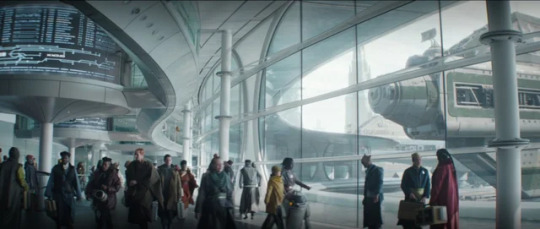
High Modernism is associated with the Cold War era of the late 1950s and 1960s-- and is therefore a DAMN good style choice for the ISB. My god. It's a design school that is all about technology and control: control over the environment, control over civic spaces, control over labor-- you name it.
The thing I associate with High Modernism above all else is the notion of state legibility: the idea that populations and spaces are organized into a structure that the state can read and therefore control. James C. Scott has a whole book about this, called Seeing Like a State. It's not my favorite of his works-- that would be Weapons of the Weak-- but his overriding thesis about how state policies of legibility are often destructive to culture and communities are worth coming back to. I mean, think about city and civil engineering, housing laws, city grids-- or Imperial sectors.
In our world, maybe the best example of High Modernism would be the work of Le Corbusier and his followers-- I mean, consider Brasilia! It's an artificially planned city, designed to reflect the aspirations of a growing nation: Ordem e Progresso, right? High Modernism tends to disregard historical realities, cultural practices, and the way people actually use spaces-- which, again, is exactly why Luke Hull is giving us this:
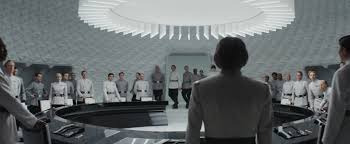
It's almost like these folks at ANDOR are good at their damn jobs, or something.
(Join me next time on SomeInstant Talks About Architecture in Andor: Wait, Is Niamos Space Acapulco, or What?)
#art and architecture#andor spoilers#andor#episode 4 spoilers#episode 7 spoilers#episode 6 spoilers#brutalism#art deco#high modernism#academic nonsense#sometimes i teach art history#production design#this is now a luke hull fanpage#star wars design#star wars#coruscant
188 notes
·
View notes